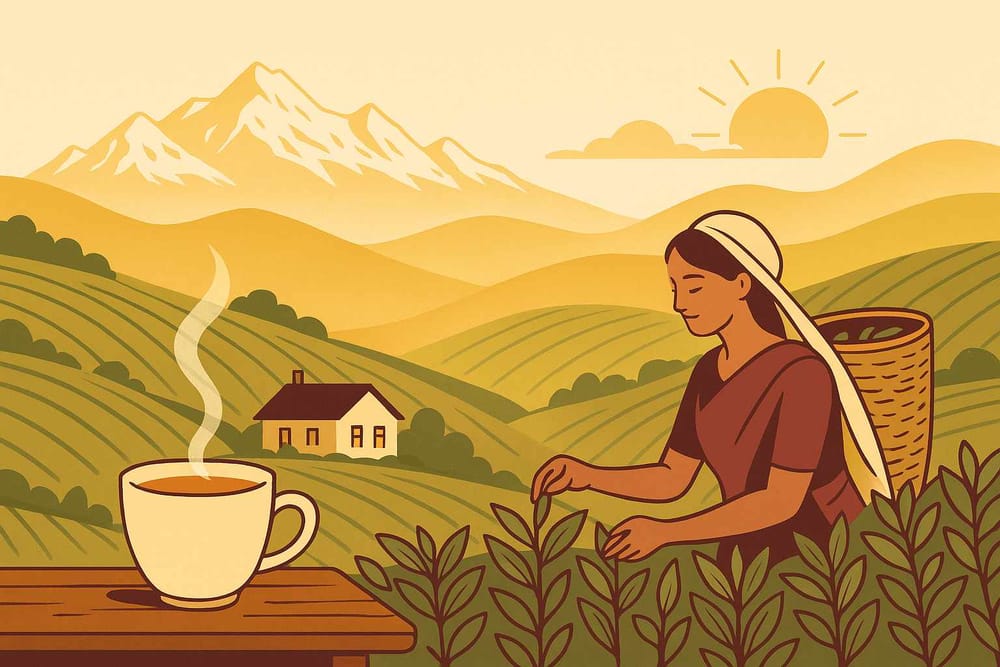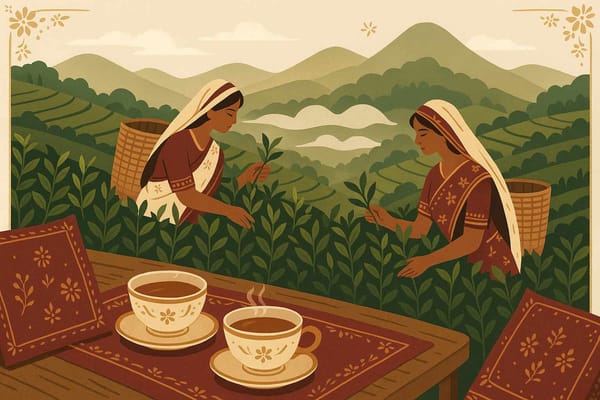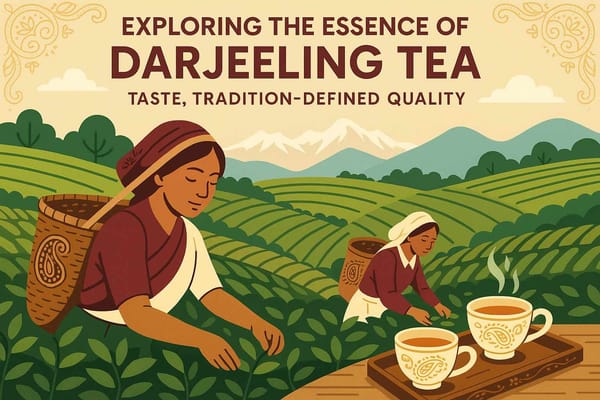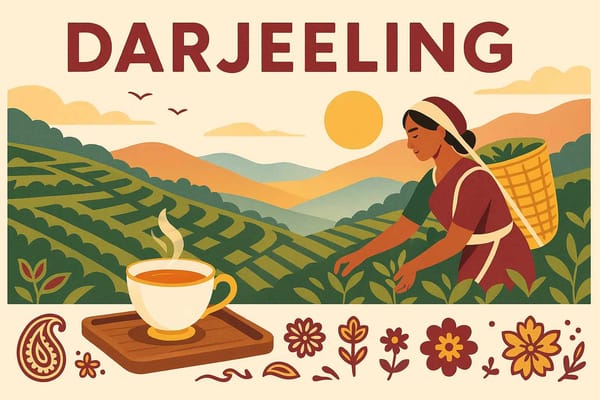
The Essence of Darjeeling Tea: Time and Taste Define Quality
There are some mornings, especially when the monsoon clouds hang low, that call for something more than just a regular cup of chai. It's a craving for a moment of quiet reflection, a connection to something pure and timeless. On days like these, I find myself reaching for my tin of Darjeeling tea. As the hot water hits the delicate, wiry leaves, a fragrance fills the air—not just of tea, but of mist-laden mountains, of cool breezes, and of a legacy carefully nurtured for generations. This isn't just a beverage; it's an experience, a journey to the heart of the Himalayas in every single sip.
Fondly called the "Champagne of Teas," this Indian treasure is so much more than its fancy title. It’s a story of our land, a testament to the artistry of our people, and a sensory delight that has captivated the world. But what truly gives this Himalayan beverage its soul? Let's uncover the magic together.
A Story Steeped in the Hills: The Origins of Darjeeling's Pride
The tale of Darjeeling tea begins not with ancient Indian traditions, but in the mid-19th century, during the British era. British planters, seeking the perfect conditions, discovered that the cool, misty slopes of Darjeeling, nestled between 600 and 2000 meters in the Himalayas, were ideal for cultivating Chinese tea saplings. The region's unique geography and fertile soil created a 'terroir' so perfect, it was as if the land was destined to produce this liquid gold.
Pioneering estates like Makaibari became the custodians of this new legacy. They didn’t just grow tea; they perfected the "orthodox" method of processing—a meticulous, hands-on approach of withering, rolling, and drying whole leaves to preserve their delicate aroma and complex flavours. This commitment to quality not only put Darjeeling on the global map but also became a source of livelihood and pride for generations of local communities, creating a beautiful synergy between nature and human craftsmanship.
The Dance of the Seasons: Understanding the Four Flushes
One of the most fascinating aspects of Darjeeling tea is how its character changes with the seasons. The flavour, aroma, and colour of the tea are dictated by when the leaves are plucked. These harvesting seasons are known as "flushes," and each one offers a completely unique experience.
- First Flush (Spring: March - May): This is the most anticipated and prized harvest of the year. The young leaves, fresh from their winter slumber, produce a tea that is light, delicate, and wonderfully floral. It has a crisp, fresh finish and a beautiful pale golden colour, often with vegetal and fruity undertones that truly capture the essence of spring.
- Second Flush (Summer: June): If the first flush is delicate, the second flush is bold and full-bodied. This is when the famous "muscatel" flavour profile comes to life—a rich, fruity note reminiscent of muscat grapes, often with hints of honey and oak. This complex and aromatic brew is a favourite among connoisseurs worldwide.
- Monsoon Flush (Late Summer: July - September): As the rains lash the hills, the tea plants grow vigorously. The tea from this flush is stronger, more robust, and has a distinct earthy undertone. While less complex than the first two flushes, its boldness makes it an excellent choice for blends or for those who enjoy a stronger cup.
- Autumnal Flush (Autumn: October - November): The final harvest of the year offers a tea that is smooth, mellow, and well-rounded. It brews a beautiful coppery liquor and carries subtle notes of ripe fruits or citrus. It’s the perfect, comforting cup to enjoy as a gentle warmth against the approaching winter chill.
The Secret Behind the Flavour: Terroir and Timeless Craft
So, what truly makes Darjeeling tea taste so different from any other? The answer lies in its unique "terroir"—a beautiful word that encompasses the soil, altitude, climate, and overall environment of the region. The Himalayan mist acts as a natural veil, slowing down the growth of the tea bushes and allowing the leaves to develop incredibly complex and nuanced flavours. The cool mountain air and the mineral-rich soil all contribute to its signature taste.
This natural gift is then honoured through meticulous processing. The best Darjeeling teas are still hand-plucked, with skilled workers selecting only the tender "two leaves and a bud." This ensures that only the finest leaves make it to the factory, where they are carefully withered and rolled by hand to unlock their rich aromas. This dedication to preserving tradition and quality is what makes every cup so special. Much like the distinct character of Darjeeling, other regions in India also hold their own unique essence. For instance, the spiritual narratives of Mewar are deeply rooted in its sacred land, telling tales of devotion and culture that have been passed down through generations.
Brewing the Perfect Cup: A Moment of Mindfulness
To truly appreciate the delicate flavours of Darjeeling tea, it's best to brew it with a little care. Always use fresh, filtered water brought to a boil and then allowed to cool for a moment. Pour the hot water over one teaspoon of leaves per cup and let it steep for about 3 to 5 minutes. Over-steeping can make it bitter, so be mindful of the time!
Many wonder if they should add milk. While tea is a personal preference, it's highly recommended to enjoy Darjeeling tea on its own, without milk or sugar. This allows its intricate floral and muscatel notes to shine through. Beyond its incredible taste, this tea is also a powerhouse of antioxidants, known to boost immunity and aid digestion, making it a healthy and soulful choice.
This connection to heritage, whether in a cup of tea or a sacred story, is what enriches our lives. The pride we feel for Darjeeling's legacy is mirrored in the valour and grace found in other corners of our country, such as the timeless tales of Rajputana in Udaipur, where every fort and lake has a story to tell.
So the next time you brew a cup of Darjeeling tea, take a moment. Inhale its beautiful aroma and let each sip transport you to the misty, green slopes of the Himalayas. You’re not just drinking tea; you’re partaking in a piece of India’s living, breathing heritage.
A Note from Bhaktilipi
At Bhaktilipi, we believe in celebrating and preserving the rich traditions that form the soul of India. From timeless devotional stories to the deeper meaning behind our rituals, our mission is to bring this sacred knowledge to you in a way that resonates with modern life. The care and tradition poured into every cup of Darjeeling tea mirrors the devotion we aim to share.
Stay connected with our heritage and find inspiration in our carefully curated content. You can subscribe to our YouTube channel and follow us on Instagram and Facebook. Join our community to explore the spiritual practices that bring peace and meaning to our daily lives.
A passionate group of people dedicated to preserving India's knowledge of Dharma, Karma, and Bhakti for ourselves and the world 🙏.
Comments
Related in

Exploring the Unique Flavors of Darjeeling Tea: A 2025 Guide
There's a certain magic that unfolds when you hold a warm cup of tea, especially when it’s from the misty slopes of Darjeeling. It’s more than just a drink; it feels like a heartfelt conversation with the mountains themselves. For many of us in India, a

Exploring the Essence of Darjeeling Tea: Taste Tradition-Define Quality
Have you ever held a warm cup, closed your eyes, and felt transported to another place? For me, that place is the misty, rolling hills of Darjeeling. There's a certain magic captured in a cup of its famous tea—a story of the mountains, the crisp air, and

The Rich Aroma: Darjeeling Tea Delivers a World of Flavor
I still remember the scent. The soft pitter-patter of monsoon rain outside, a cool breeze wafting through the veranda, and my grandmother carefully brewing a pot of tea. It wasn’t just any chai; it was her special Darjeeling tea. The aroma that filled our home was delicate, almost like
